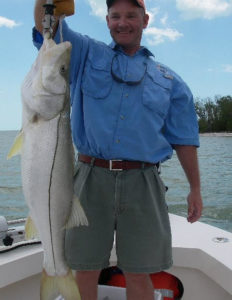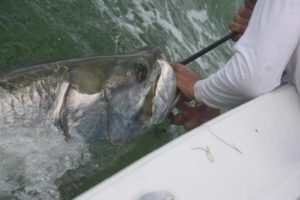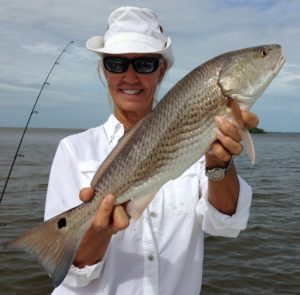
Snook – FL Record 44 lbs 3 ozs
Snook can be found in most areas of the Everglades, including the back-country where there is freshwater. I use live bait, which can be very effective, the type depending upon availability and time of the year. Cut bait, such as ladyfish and mullet, are effective for larger snook, also. In the winter, I change to shrimp when fishing for snook.
When these fish strike, they strike with a vengeance. Once hooked, a snook will be airborne for 50% of the fight, and will fight like a bass on steroids. On a good day, you might catch 10 snook per angler. Snook can be fished all year, but the open season runs from September through November, and from March through April. All other times are catch and release for these fish.

Tarpon – FL Record 243 lbs
Everglades tarpon fishing is a hunting game; it is sight fishing in its purist form. These fish migrate daily and new schools may be found elsewhere the next day. Tarpon can be found along the beaches, rivers, and well into the back-country of the Everglades. I run in and out of creeks and bays until I locate them. Once found, I use an electric troll motor to sneak up on them, to allow better casting.
Fighting a 100+ lb. tarpon in 3 feet of water, in a creek no wider than my dock (100ft.) is very challenging to say the least! This is done on light spinning tackle, with artificial lures. Feeling a tarpon first strike a lure is like snagging a rock. Then the rock turns, makes a run of about 50 feet, and is then airborne for most of the fight. When a tarpon jumps, you “bow to the tarpon”, pointing your rod directly at the fish, so the line does not break. It can take from 30 minutes to an hour (depending on the skill level of the angler) to land one of these giants. Everglades tarpon migration starts about March and finishes during the summer months. There are Everglades tarpon resident throughout the year, but these are harder to find and smart enough to elude most fishermen.

Redfish – FL Record 52 lbs 5 ozs
Ready for more challenge? Nothing is more exciting than to hook up with a 20 lb. Everglades redfish along a mangrove shoreline. These wily fish will test you in areas with numerous underwater snags and stumps, and, once caught and brought to the boat, will make a run for the motor to cut the line. These fish love to hit (bite) spoons, jigs, and shrimp. Redfish is available all year, but the best time is in the fall. I fish for redfish anywhere there is water: on the beach, in the rivers, in back bays and the upper reaches of remote creeks where saltwater turns to fresh. In these backcountry areas, you might catch a redfish on one cast, and a snook on the next. Redfish are open all year. On a good day, it is not uncommon to catch 15 redfish.

Spotted Seatrout – FL Record 17 lbs 7 ozs
Trout are plentiful, can be caught year-round and may be caught and enjoyed by the whole family. That said, you may only keep 4 of these fish per person. They are usually caught on the grass flats, but can be caught in abundance in the mouths of rivers and creeks, in the back-country bays, as well as along the mangrove islands. These fish love to strike a jig but can be caught on most lures, but I find using a shrimp under a popping cork the most productive way to catch trout.

